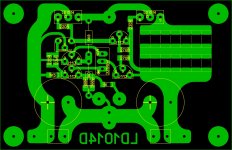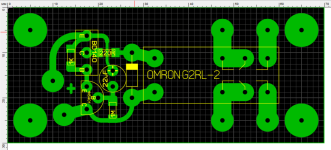I post the full Fourier Analysis of this amplifier at 1 Watt 8 Ohm.
Have a look.
Notice the very dominant 2nd harmonic.
This is what Nelson Pass is going for in his amplifiers.
He has also used LU1014D. In fact he has helped to make it popular.
But the second harmonic in this amplifier has got a positive phase. As can be seen.
This is not perfect in the eye of Nelson. He likes the phase of 2nd to be negative.
Well, one can not get everything.
Here it is:

Have a look.
Notice the very dominant 2nd harmonic.
This is what Nelson Pass is going for in his amplifiers.
He has also used LU1014D. In fact he has helped to make it popular.
But the second harmonic in this amplifier has got a positive phase. As can be seen.
This is not perfect in the eye of Nelson. He likes the phase of 2nd to be negative.
Well, one can not get everything.
Here it is:
@ggetzoff a 6s lipo goes from ~25V when fully charged to 18V when completely discharged.
Changing the power supply voltage will change the sound too, you need a voltage regulator after the battery.
Do you use one or power the amp directly from the battery?
How do you perceive the sound of the amp when the battery is fully charged/discharged ?
If you have a dc coupled amp powered from a bipolar power supply and each half draws slightly different currents then the batteries will discharge at different voltages which will create a dc offset at the output of the amp.
To mention also that for a bipolar power supply you need both packs to have same capacity or else as they discharge the voltage of each will be different creating a dc offset at the output of the amp.
Batteries are nice but extra care needs to be taken.
Changing the power supply voltage will change the sound too, you need a voltage regulator after the battery.
Do you use one or power the amp directly from the battery?
How do you perceive the sound of the amp when the battery is fully charged/discharged ?
If you have a dc coupled amp powered from a bipolar power supply and each half draws slightly different currents then the batteries will discharge at different voltages which will create a dc offset at the output of the amp.
To mention also that for a bipolar power supply you need both packs to have same capacity or else as they discharge the voltage of each will be different creating a dc offset at the output of the amp.
Batteries are nice but extra care needs to be taken.
Because I like create something of my own.So why propose this one?
//
Something different.
This gives me great pleasure doing this.
I already mention the need for two batteries for the bipolar supply.@ggetzoff a 6s lipo goes from ~25V when fully charged to 18V when completely discharged.
Changing the power supply voltage will change the sound too, you need a voltage regulator after the battery.
Do you use one or power the amp directly from the battery?
How do you perceive the sound of the amp when the battery is fully charged/discharged ?
If you have a dc coupled amp powered from a bipolar power supply and each half draws slightly different currents then the batteries will discharge at different voltages which will create a dc offset at the output of the amp.
To mention also that for a bipolar power supply you need both packs to have same capacity or else as they discharge the voltage of each will be different creating a dc offset at the output of the amp.
Batteries are nice but extra care needs to be taken.
Minimum cell voltage for a LiPO is 3.7v, so 6s is NOT 18v, but 22.2v. I already addressed all of these concerns in the mini thread. All of the burn your house down and voltage / bias questions.
I run a voltage monitor that alarms when any cell gets to min V. It’s a $5 monitor works great. I’ve been using hi voltage lipos for 20 years now in RC. Yes, you have to observe some precautions. I’ve never had a problem with them, except when I run them into the earth at a couple of hundred Gs. Even then I’ve never had a fire. You just use quality charging and common sense with LiPOs.
I
I was just explaining what can happen when 2 batteries are used for a bipolar power supply.
I don’t follow the mini thread so I didn’t know about you mentioning it there. Mentioning it here can help other users like me (that don’t follow that thread) understand better the risks when using batteries in certain conditions.
Sorry but for a lipo 3.7V is the nominal voltage. The minimum is 3V or even lower like 2.7V
All these 20 years you discharged your lipos to only 3.7v/cell?
Please don’t get me wrong, I was curious if you hear any difference in sound when the battery voltage changes.
I don’t follow the mini thread so I didn’t know about you mentioning it there. Mentioning it here can help other users like me (that don’t follow that thread) understand better the risks when using batteries in certain conditions.
Sorry but for a lipo 3.7V is the nominal voltage. The minimum is 3V or even lower like 2.7V
All these 20 years you discharged your lipos to only 3.7v/cell?
Please don’t get me wrong, I was curious if you hear any difference in sound when the battery voltage changes.
Traditionally, we never discharged them below 3.7v so you don’t have motor or radio cutout! So yes, I have always adhered to that.I was just explaining what can happen when 2 batteries are used for a bipolar power supply.
I don’t follow the mini thread so I didn’t know about you mentioning it there. Mentioning it here can help other users like me (that don’t follow that thread) understand better the risks when using batteries in certain conditions.
Sorry but for a lipo 3.7V is the nominal voltage. The minimum is 3V or even lower like 2.7V
All these 20 years you discharged your lipos to only 3.7v/cell?
Please don’t get me wrong, I was curious if you hear any difference in sound when the battery voltage changes.
I do not hear any difference nor does the bias drift. I do warm it up for an hour on wart power, then swap in a battery. The amp on battery power is just killer sounding.
Lineup,
since I have 100 of these LUs, I wouldn't mind trying to build this one. One thing I would do is to combine both boards on a single one to cut down fab costs. How does the circuit do with PS rejection? Would reg PS help? Sorry if this is asked and answered already.
since I have 100 of these LUs, I wouldn't mind trying to build this one. One thing I would do is to combine both boards on a single one to cut down fab costs. How does the circuit do with PS rejection? Would reg PS help? Sorry if this is asked and answered already.
Now let's talk Power Supply for Small Amplifier.
The need is +/-12.0 Volt.
Transformer should be 2x15VAC.
Preferably 150 or 200VA.
300VA should not hurt for feeding both channels.
Here is a suggestion for supply circuit.
It is a Transistor Boosted LM317/LM337.
It is a simple way to get very precise supply.

The need is +/-12.0 Volt.
Transformer should be 2x15VAC.
Preferably 150 or 200VA.
300VA should not hurt for feeding both channels.
Here is a suggestion for supply circuit.
It is a Transistor Boosted LM317/LM337.
It is a simple way to get very precise supply.
That is also one way to do it.LM317+LM337 need 4V-5V droping between Vin and Vout for effective work. More easy to build a simple JLH voltage regulator.
I want the supply to be regulated.
There are many ways to do this.
Your suggestion is a good one.
Why this amplifier use +12V and -12V is because LU1014D can only take 24V.
Should there be diodes across the CE of 3055 & 2955?Now let's talk Power Supply for Small Amplifier.
The need is +/-12.0 Volt.
Transformer should be 2x15VAC.
Preferably 150 or 200VA.
300VA should not hurt for feeding both channels.
Here is a suggestion for supply circuit.
It is a Transistor Boosted LM317/LM337.
It is a simple way to get very precise supply.
View attachment 1158947
- Home
- Amplifiers
- Pass Labs
- LU1014D Small Amplifier 6 Watt with low distortion


